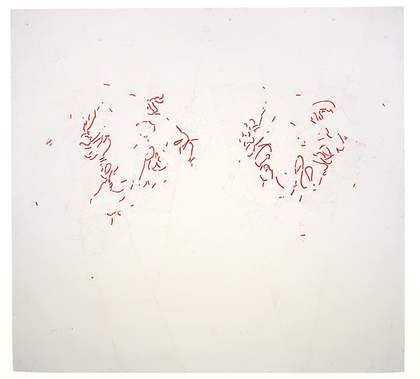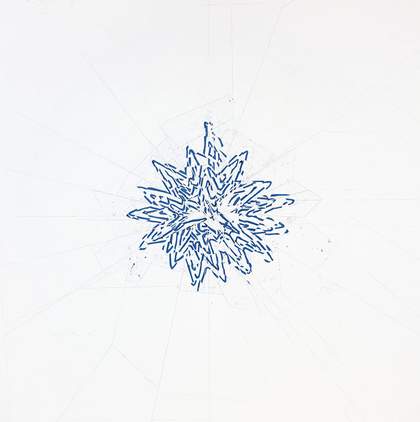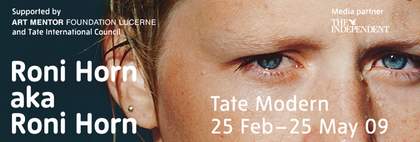Roni Horn is best known in this country for her sculptures, her books and her photographic installations, such as 1999’s Still Water (The River Thames, for Example). Less well known and rarely seen (at least in the UK) are her drawings, yet the artist has said that ‘if you were to ask me what I do, I would say that I draw – this is the primary activity’. Drawing has always played an interesting role in relation to her sculpture and rarely a subsidiary or preparatory one: for instance, in the same years that she worked with paired copper objects which she placed in adjacent rooms, she also made paired drawings, hanging them either on separate walls or in separate spaces. The small forms on each were pretty similar, but viewers could never compare them exactly; instead they might attempt to recall the first while looking at the second, and in this process, the experience of both parts would change.
Horn called this series Distant Doubles 1989 since two sheets were separated in the gallery space. But even single drawings were cut apart, not that this would be visible right away. One of her most compelling early pigment drawings is As IX 1988. Three oval forms float on the lower half of the paper; the red darkens towards their sides and bottoms, as if to suggest solid objects whose edges are cast in shadow. Try as you might to view them as abstract forms, you see heads – heads such as those that began to appear as skulls in Philip Guston’s paintings of the early 1960s. Very close up you realise that though they touch, they are not actually on one single plane. The main body of paper is sliced almost down the middle, and the central shape, which has been cut out, overlaps from one half to the other. Flush with one part, it is raised slightly above the abutting sheet.

Roni Horn
As IX 1987–8
Pigment and varnish on paper
The Museum of Modern Art, New York. The Judith Rothschild Foundation Contemporary Drawings Collection Gift, 2005
© The artist, courtesy Hauser & Wirth Zürich London
Since the mid-1990s, the solid shapes that inhabited earlier works have disappeared and Horn’s drawings have grown substantially in size. They now begin with lines made of charcoal and loose pigment, gradually fixed with layers of varnish on sheets of artist’s paper to make what Horn calls ‘plates’. The lines are flowing, sometimes in graceful swirls reminiscent of those in Brice Marden’s recent paintings, sometimes in recognisable shapes such as spirals. Once complete, two or more of these plates are cut up with a razor into hundreds of straight-edged small sections, which are then re-constellated and pinned to a board until a final arrangement is determined. All the fragments are used, and there is no overlap. New blank plates are also cut apart and sections inserted into the composition. During the process, smudges of pigment make their way from the lines to the outer sections of the paper. Small pencil annotations are also made, often in pairs across a break of paper. These are numbers and sometimes words. The compositions vary greatly. In some, large recognisable shapes occur, such as the star-like figure in Through 4 2007. However, it is unclear whether this was on the original plate, or was created by lines which earlier had taken a completely different form. Many drawings feature two clusters of cut-up lines; initially these pairs of shapes appear similar, but soon their only resemblance is the way in which each is formed by fragments. In Were 13 2004, the original plates included crossed lines. The central “x” in each large cross was cut out of its place and rotated so that in the final drawing we see crosses with jolted centres. Horn’s use of negative space is as remarkable as her treatment of the pigmented lines. In Were 3 2002, for instance, there are matching, almost rectangular, empty “gaps” in the two main clusters; in Were 11 2004, there are a series of diagonal lines which are gaps between its cascading red lines. The very identity of line in these drawings is mutable: there are the lines of the pigment, the lines of blank paper between them, and everywhere the lines of the razor cuts between each section of paper. Horn’s use of space is particularly daring: the clusters tend to be surrounded by huge empty expanses made by cut-up blank plates; these areas can seem desolate, but are animated by cuts between the blanks, and their expansiveness gives the works a huge scale as well as size. Colour is used sparingly but powerfully. Many drawings feature one colour only – a deep red pigment, or a deep blue; however, some compositions juxtapose a dominant colour with another one. In the majestic Were 13, most of the lines are lime green, but here and there we find blips of red-brown pigment. From afar, these blips direct the eye around the piece so that we begin to see it in parts and not as a whole.

Roni Horn
Were 4 2002
Pigment and varnish on paper
Private Collection
© The artist, courtesy Hauser & Wirth Zürich London
Many commentators have approached these drawings by focusing on the processes of their making. This is unsurprising as their construction is extraordinary. Horn’s process has nothing to do with collage, where fragments overlap and space is usually compressed rather than opened out. Nor do her works have any more than superficial resemblance to other kinds of drawings made from cutting up and rearranging lines, such as those by Ellsworth Kelly in 1950 that employed chance; by contrast, Horn’s rearrangements are completely deliberate. The brokenness of her line also marks her distance from traditions of gestural and automatic drawing. Writers (myself included) have described the viewer’s experience of trying – and failing – to fathom the exact stages of her work. This sense of doubt about the nature of the process is part of the experience of the drawings, and all the more powerful because the annotations on them can seem to imply the existence of a compositional system that we could figure out – if only we were attentive enough. But faced with the final drawing there is no way of discovering what previous forms the composition took as it came to formation. Horn is neither playing games with secret systems, nor tempting us to ‘work out’ her operations. In fact, she does not mystify her process and has published a technical note clearly describing materials and explaining their fabrication. Where many artists in the 1950s and 1960s found ways of making drawings that avoided subjective decision making and intuition, she unashamedly describes the composition procedure as one of improvisation and slow determination: the final product is arrived at through intuitive and personal decisions. Setting aside discussions of process, then, other approaches to Horn’s drawings can be productive. Comparing them with, on the one hand, Eva Hesse’s graph paper drawings, which invoke a series of patient repeated acts over the slow progress of time, and, on the other, Willem de Kooning’s, which appear to be made with a handful of quick expressionist gestures, we can consider their temporality. Drawings can invoke slow or fast time; the temporality of Horn’s is much harder to fathom. The initial lines were made quite quickly; by contrast, the cutting apart and reconfiguring of the composition could last for months. Two speeds are at work here and the final works give a corresponding sense of broken time; of time out of joint. In turn, the time of our viewing seems to break into pieces, and we have a palpable awareness of time’s irreversibility: there is no way to turn back time to reassemble the fragments into their original place.
But then again, in the final composition, the fragments are in place – their new place. One of the striking things about the drawings is that everything is fragmented and yet everything fits perfectly. This would seem contradictory, but it is their condition. Realising this, they can be taken as analogues of, and propositions for, a kind of thinking. They are diagrams of thought – not of a thought or a series of ideas, but of thought in general. Instead of proposing it as direct and clearly purposed, they advocate (since they are the outcome of ) thought that lets itself undergo fragmentation, dispersal and division, knowing that these processes, while risky, can be a route towards a new kind of coherence. There is a connection here to Deleuze and Guattari’s contrast of ‘arborescent’ and ‘rhizomatic’ thought: Horn’s drawings reject the hierarchy and directness of the arborescent for the multiplicity of the rhizomatic.
Finally, returning to their connection to her sculpture, the artist has commented that her ‘drawings do not necessarily involve sculpture – except in the understanding of materiality, physicality and presence’. As for materiality, when seen close up, the lines are raised above the surface of the paper and one can sense the substance of pigment.

Roni Horn
Through 4 2007
Pigment and varnish on paper
Whitney Museum of American Art; purchased with funds from Kathy and Richard S Fuld Jr, 2008 © The artist, courtesy Hauser & Wirth Zürich London
However, the more interesting relationship to sculpture has to do with the presence and physicality of the entire drawing in space, with the way in which a viewer approaches it as an object. From a distance, the large drawings have a graphic identity: we might recognise one as a star and another as a cascade. However, as one approaches, this identity shifts: the details of the construction become more apparent; the lines appear to be broken; the cuts become as prominent as the lines; the pencil annotations become visible. Very close, when the works are large enough to fill your view, you forget the shape of the main linear form entirely and instead concentrate on the intricacy of the composition. In not dissimilar ways, Horn’s sculptures also change in space and time. Her glass works, for instance, are sometimes extremely reflective, and sometimes intensely transparent, allowing you to see right through them to the magnified miniature landscapes on their bases. This shift in appearance depends on your movement and the movement of light around the sculptures. You realise that they do not have a fixed visual identity, but a changing one.
The drawings share this condition of mutability. They do not literally change shape or materiality, but they appear to in the viewing encounter. If the viewer accepts this shifting as part of their meaning, he or she might connect these works with Horn’s conception of identity: ‘The mutable version of identity is not an aberration… the fixed version is the aberration.’ Critical of binary opposites and of fixed categories of identity, the artist proposes androgyny: ‘Androgyny is the possibility of a thing containing multiple identities. Integrating identity is the basis of identity, not the exclusion of it. You are this and this and that.’ The drawings she makes change their identity over time and in space; as we experience them we come to accept and appreciate mutability and becoming in the place of solidity and singularity.

